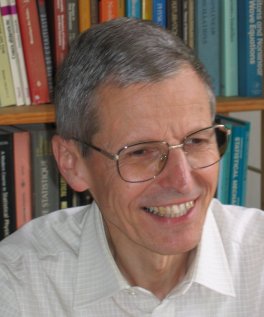

|
Professeur de Physique,
e-mail: Michel.Peyrard-at-ens-lyon.fr
|
What can we learn from the dynamics of the
Covid-19 epidemic ?
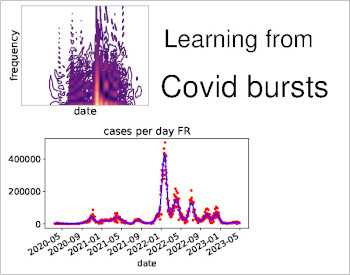
|
The dynamics of the Covid-19 epidemic exhibits quasi-periodic
outbursts, which cannot be assigned to seasonal outbreaks. Is there an
underlying mechanism behind these phenomena ? Can we understand some
fundamental properties of the epidemic by an analysis of the data ?
This is what this paper intends to show.
Data for France and Germany show that the patterns of outbursts exhibit a qualitative change in early 2022, which appears in a change in their average period, and which is confirmed by the time-frequency analysis. This provides a signal that can be used to discriminate among several mechanisms. Two main ideas have been proposed to explain periodicity in epidemics. One involves memory effects and another considers exchanges between epidemic clusters and a reservoir of population. We test these two approaches in the particular case of the Covid-19 epidemics and show that the ``cluster model'' is the only one that appears to be able to explain the observed pattern with realistic parameters. The last section discusses our results in the context of early studies of epidemics, and we stress the importance to work with models with a limited number of parameters, which moreover can be sufficiently well estimated, to draw conclusions on the general mechanisms behind the observations. Reference: M. Peyrard, Chaos 33 103101 (2023) - (Reprint) |
How is information transmitted in a nerve?
|
In the last fifteen years a debate emerged about the validity of the famous
Hodgkin-Huxley model for nerve impulse. Mechanical models
involving solitons have been
proposed. This note reviews the experimental properties of the nerve impulse
and discusses the proposed alternatives to the Hodgkin-Huxley model.
The experimental data, which rule out some of the alternative suggestions, show that, while the Hodgkin-Huxley model may not be complete, it nevertheless includes essential features that should not be overlooked in the attempts made to improve, or supersede, it. Reference: M. Peyrard, Journal of Biological Physics, dx.doi.org/10.1007/s10867-020-09557-2 (2020) (Preprint) - (Read the published paper on-line) |
|
There are observations which detect differences between the
exponents of the Omori law for foreshocks and aftershocks, as well as
variations of the b exponent of the
Gutenberg-Richter law for main shocks,
foreshocks and aftershocks which cannot be accounted for, unless one relies on
phenomenological or statistical models with ad-hoc assumptions.
The model that we studied with Oleg Braun (Institute of Physics, Kiev) describes all these observations within a framework based on the physics of the rocks, which introduces a natural length scale, the elastic correlation length, and provides quantitative values for most of the the model parameters. The results are robust with respect to large variations of the few parameters which cannot be readily obtained from physical data. Reference: O.M. Braun and M. Peyrard, EPL, 126 49001-1-7 (2019) (Preprint) - (EPL 2019) |
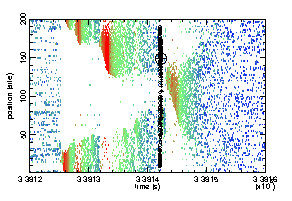
|
DNA structure: the story is still going on
|
In 1953 J.D. Watson and F.H.C. Crick built a three-dimensional model of the
famous double helix of DNA, which earned them the Nobel Prize [1]. But this
discovery did not end the story of DNA structure. In 1975 F.H.C. Crick and
A. Klug proposed a second model, suggesting kinks in DNA. These sharp angles
in the helix have nothing to do with the flexible joints due to single strand
breaking and base-pair opening. They are well defined structures, connecting
two helical segments at an angle of about 95°, in which all base pairs are
intact and all bond distances and angles are stereochemically acceptable.
Crick and Klug suggested that such kinks could contribute to the folding of DNA in chromatin but they also wondered whether kinks could occur spontaneously in double-stranded DNA in solution. This question remained opened since 1975 because structure determinations for molecules freely moving in solution are very challenging. Our recent study, combining small-angle X-Ray and neutron scattering with a statistical physics analysis of the data [3] showed that kinks can indeed exist in some DNA sequences in solution. This confirms the intuition of Crick and Klug and opens a new view point on DNA structure. The well known image of the rigid double helix has to be completed, and for instance viruses might take advantage of such kinks to pack DNA in their capsides. [1] J.D. Watson and F.H.C. Crick, A Structure for Deoxyribose Nucleic Acid. Nature 171, 737 (1953) [2] F.H.C. Crick and A. Klug, Kinky Helix. Nature 255, 530 (1975) [3] T. Schindler et al., Kinky DNA in solution: Small angle scattering study of a nucleosome positioning sequence. Phys. Rev E 98,042417 (2018) Phys. Rev E 98,042417 (2018) |
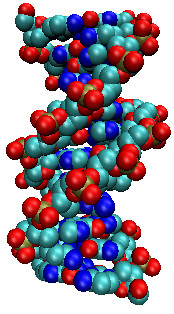
|
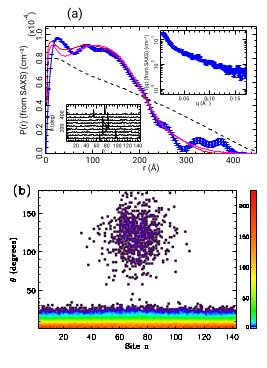
|
Physique des Solitons / Physics of Solitons
|
Depuis la première observation d'un soliton en 1834,
ces ondes solitaires aux caractéristiques exceptionnelles fascinent les
scientifiques en raison de leurs propriétés expérimentales
très spectaculaires, des développements mathématiques remarquables
auxquels leur étude a conduit, mais aussi parce que
l'approche en terme
de solitons permet de renouveler en profondeur le point de
vue sur de nombreux problèmes physiques. Dans cet ouvrage les fondements sont introduits à partir d'exemples de la physique macroscopique (hydrodynamique, ondes de pression sanguine, océanographie, communications par fibres optiques,...). Les principales méthodes théoriques sont ensuite abordées, avant la présentation détaillée de nombreuses applications consacrées à des problèmes microscopiques de la physique des solides (dislocations, chaînes de spins, polymères conducteurs, matériaux ferroélectriques) ou des macromolécules biologiques (transfert de l'énergie dans les protéines, dynamique de la molécule d'ADN). (Erratum)
This textbook
introduces the basic properties of solitons from examples in
macroscopic physics (water waves, blood pressure pulse, optical fiber
communications, ...). The main theoretical methods are
introduced in a second part.
Numerous applications are then discussed in detail in
solid state or atomic physics (dislocations, excitations in spin chains,
conducting polymers, ferroelectrics, Bose-Einstein condensates) and
biological physics (energy transfer in proteins, DNA fluctuations).
|

|
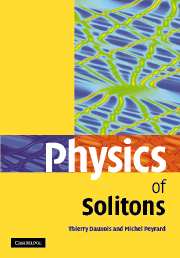
|
In his famous book "What is life?", addressing the question "how can
we explain the basic phenomena of life with physics and chemistry", E.
Schrödinger points out that one essential character of life is
its ability to show cooperative behaviors. Instead
of the incoherent fluctuations of atoms or small molecules in
solution, living cells show coherent global dynamics. Cooperativity
has also been found to be a very important feature that can deeply
affect the behavior of nonlinear systems. While a
few nonlinear oscillators can show chaotic dynamics, a nonlinear
lattice made of such oscillators coupled to each other, may on the
contrary exhibit coherent excitations such as solitons or nonlinear
localized modes.
Nonlinear cooperative systems are interesting because they can exhibit spectacular properties, but also because they provide paradigms which are useful to understand many physical observations, from friction at the microscopic scale to the dynamics of biological molecules. My research interests cover both the fundamental properties of nonlinear lattices and their applications in condensed matter and biomolecular physics. Some selected results are presented below.
For further information on the research carried in the Laboratoire de
Physique de l'ENS-Lyon, check
the laboratory home page
La physique de la matière condensée va-t-elle redécouvrir
l'espace?
The design of a thermal rectifier
(Europhysics Letters Editorial Board
highlights of 2006)
While electronics has been able to
control the flow of charges in solids for decades,
the control of heat flow still seems out of reach, and this is why,
when a paper showed for the first time how to build a
``thermal
rectifier'', the thermal analogue of the electrical
diode, it attracted a great deal of attention.
The idea that one can build a solid-state
device that lets heat flow more easily in one way than in the other,
forming a heat valve, is counter-intuitive and may even appear in
contradiction with thermodynamics. Actually this is not the
case, and the design of a thermal rectifier can be easily understood
from the basic laws of heat conduction. Here we show how it
can be done. This analysis exhibits several ideas that could in
principle be implemented to design a thermal rectifier, by selecting
materials with the proper properties. In order to show the feasibility
of the concept, we complete this study by introducing a simple model
system that meets the requirements of the design. Such devices could
be useful in nanotechnology, and particularly to control he heat flow
in electronic chips.
Nonlinear localization in lattices.
Statistical properties of one dimensional ``turbulence''.
Controlling the energy flow in nonlinear lattices:
a model for a thermal rectifier.
Dynamics and statistical mechanics of nonlinear lattices.
Conférence présentée à l'assemblée générale de l'Institut
Universitaire de France, Toulouse, 1999
(Texte de la conférence)
Reference: M. Peyrard, Europhys. Lett. 76 49-55 (2006)
(reprint)
Reference: M. Peyrard, Physica D 119, 184-199 (1998).
(reprint)
We study a one-dimensional discrete analog of the von Karman flow,
widely investigated in turbulence. A lattice of anharmonic oscillators
is excited by both ends in order to create a large scale structure in
a highly nonlinear medium, in the presence of a dissipative term
similar to the viscous term in a fluid. This system shows a striking
similarity with a turbulent flow both at local and global scales.
The properties of the nonlinear excitations of the
lattice provide a partial understanding of this behavior
Reference: M. Peyrard and I. Daumont,
Europhysics Letters 59, 834-840 (2002)
(preprint)
We address the problem of heat conduction in 1-D nonlinear chains; we
show that, acting on the parameter which controls the strength of the
on site potential inside a segment of the chain, we induce a
transition from conducting to insulating behavior in the whole
system. Quite remarkably, the same transition can be observed by
increasing the temperatures of the thermal baths at
both ends of the chain by the same amount.
The control of heat conduction by nonlinearity
opens the possibility to propose new devices such as a thermal
rectifier.
Reference: M. Terraneo, M. Peyrard, and G. Casati,
Phys. Rev. Lett., 88 094302-1-4 (2002)
(preprint)
Nature Science Update
The article by Riera-Campeny, Mehboudi, Pons, and Sanpera [Phys. Rev. E
99, 032126 (2019)] studies heat rectification in a network of harmonic
oscillators which is periodically driven. Both the title and
introduction stress the quantum nature of the system. Here we show that
the results are more general and are equally valid for a classical
system, which broadens the interest of the paper and may suggest further
pathways for a basic understanding of the phenomenon.
Reference: Michel Peyrard,
Phys. Rev. E, 101 016101-1-3 (2020)
(reprint)
Solitons and non-dissipative diffusion
Diffusion is in general associated with dissipation. If a test particle
is injected in a diffusing medium with a velocity above the thermal
velocity, it slows down. This happens because a physical
particle constantly exchanges momentum with the medium;
momentum exchange however is not a prerequisite for
diffusion. Solitons can exhibit non-dissipative diffusion because
their interaction with the other components
of the medium consists of spatial shifts, ``jumps'', rather than
momentum exchanges. At finite
temperatures the sequence of spatial shifts becomes
intrinsically stochastic.
Reference: N. Theodorakopoulos and M. Peyrard,
Phys. Rev. Lett 83, 2293-2296 (1999)
(reprint)
The flexibility of DNA has been the object of many studies, but its fundamental understanding is still lacking, and even measurements appear to disagree between each other as they depend in a subtle way on many parameters and experimental methods. How DNA bends is important for biology, but it can also be an indirect marker of the opening fluctuations of the double helix.
Base Pair Openings and Temperature Dependence of DNA FlexibilityThe famous image of the double helix gives a false image of stability. Actually DNA fluctuates widely. Its base pairs open and close. The lifetime of a closed pair is only of the order of 10 ms. These fluctuations are important for biology, but they also rise many fascinating questions for physics. Theory can describe them but experiments are essential to validate those approaches.
Small angle scattering as a tool to study the thermal denaturation
of DNA
DNA thermal denaturation is the breaking of the base pairs,
leading to a splitting of the two strands of the double helix.
While it is easy to measure the fraction of open base pairs (f)
versus temperature, determining the fraction
(p) of
fully open molecules is much harder.
Previously, the simultaneous
recording of f and p could only be achieved for special
sequences. We show that small angle scattering of X-rays or neutrons
allows the measurement of $p$ for any sequence. We illustrate the
method with a SAXS investigation of two sequences designed to exhibit
different melting profiles and compare the SAXS data with
nano-calorimetric measurements of the melting curve.
Reference: Kathleen Wood, Robert Knott, Ognyan Tonchev, Dimitar Angelov,
Nikos Theodorakopoulos and Michel Peyrard.
Europhys. Lett. (EPL) 108 18002 (2014)
EPL article
,
reprint
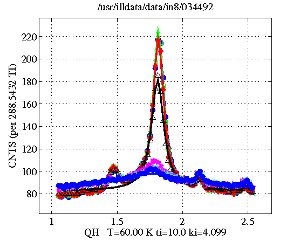 The thermal denaturation of DNA studied with neutron scattering
The thermal denaturation of DNA studied with neutron scattering
The melting transition of deoxyribonucleic acid (DNA), whereby the strands of
the double helix structure completely separate at a certain temperature, has
been characterized using neutron scattering. A Bragg peak from B-form fibre
DNA has been measured as a function of temperature, and its widths and
integrated intensities have been interpreted using the Peyrard-Bishop-Dauxois
(PBD) model with only one free parameter. The experiment is unique, as it
gives spatial correlation along the molecule through the melting transition
where other techniques cannot.
Reference: Andrew Wildes, Nikos Theodorakopoulos, Jessica Valle-Orero,
Santiago Cuesta-Lopez, Jean-Luc Garden, and Michel Peyrard,
PRL 106 048101-1-4 (2011)
reprint
The Melting of Highly Oriented Fibre DNA Subjected to Osmotic Pressure
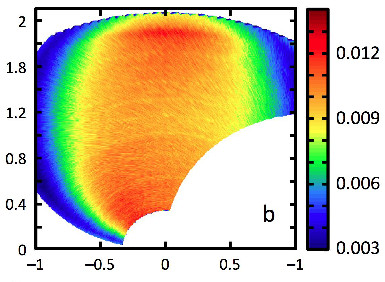 A pilot study of the possibility to investigate the temperature-dependent
neutron scattering from fibre-DNA in solution is presented. The study aims to
establish the feasibility of experiments to probe the influence of spatial
confinement on the structural correlation and the formation of denatured
bubbles in DNA during the melting transition. Calorimetry and neutron
scattering experiments on fibre samples immersed in solutions of polyethylene
glycol (PEG) prove that the melting transition occurs in these samples, that
the transition is reversible to some degree, and that the transition is broader
in temperature than for humidified fibre samples. The PEG solutions apply an
osmotic pressure that maintains the fibre orientation, establishing the
feasibility of future scattering experiments to study the melting transition in
these samples.
A pilot study of the possibility to investigate the temperature-dependent
neutron scattering from fibre-DNA in solution is presented. The study aims to
establish the feasibility of experiments to probe the influence of spatial
confinement on the structural correlation and the formation of denatured
bubbles in DNA during the melting transition. Calorimetry and neutron
scattering experiments on fibre samples immersed in solutions of polyethylene
glycol (PEG) prove that the melting transition occurs in these samples, that
the transition is reversible to some degree, and that the transition is broader
in temperature than for humidified fibre samples. The PEG solutions apply an
osmotic pressure that maintains the fibre orientation, establishing the
feasibility of future scattering experiments to study the melting transition in
these samples.
Reference: Andrew Wildes, Liya Khadeeva, William Trewby, Jessica
Valle-Orero, Andrew Studer, Jean-Luc Garden and Michel Peyrard,
J. Phys. Chem. B 119, 4441-4449 (2015)
(preprint)
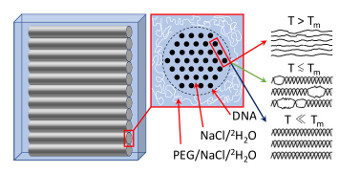 The Melting Transition of Oriented DNA Fibers Submerged
in Polyethylene Glycol Solutions Studied by Neutron
Scattering and Calorimetry
The Melting Transition of Oriented DNA Fibers Submerged
in Polyethylene Glycol Solutions Studied by Neutron
Scattering and Calorimetry
Neutron scattering was used
to monitor the integrated intensity and width of a Bragg peak from the B-form
of DNA immersed in solutions of polyethylene
glycol (PEG) as a function of temperature.
The data were quantitatively analyzed
using the Peyrard-Bishop-Dauxois (PBD) model. The experiments and analysis
showed that long segments of double-strand DNA persist until the last stages of
melting, and that there appears to be a substantial increase of the DNA
dynamics as the melting temperature of the DNA is approached.
Reference: Adrián González,
Andrew Wildes, Marta Marty-Roda, Santiago Cuesta-López,
Estelle Mossou, Andrew Studer, Bruno Demé, Gaël Moiroux, Jean-Luc Garden,
Nikos Theodorakopoulos and Michel Peyrard,
J. Phys. Chem. B (2018)
(preprint)
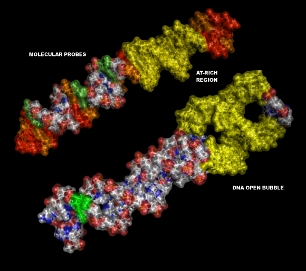
Guanine radical chemistry reveals the effect of thermal
fluctuations in gene promoter regions.
DNA is not the static entity that structural pictures suggest.
It has been longly known that it “breathes” and fluctuates
by local opening of the bases. Here we show that the effect
of structural fluctuations, exhibited by AT-rich low stability
regions present in some common transcription initiation
regions, influences the properties of DNA in a distant range
of at least 10 base pairs. This observation is confirmed by
experiments on genuine gene promoter regions of DNA. The
spatial correlations revealed by these experiments throw a
new light on the physics of DNA and could have biological
implications, for instance by contributing to the cooperative
effects needed to assemble the molecular machinery that
forms the transcription complex.
Reference: Santiago Cuesta-Lopez, Hervé Menoni, Dimitar Angelov,
and Michel Peyrard, Nucleic Acids Research 2011; doi: 10.1093/nar/gkr096
Paper (Nucleic Acid Research)
Modelling DNA at the mesoscale: a challenge for nonlinear
science?
(Invited paper for the series "Open Problem" of Nonlinearity
Article (Nonlinearity)
When it is viewed at the scale of a base pair, DNA appears as a
nonlinear lattice. Modelling its properties is a fascinating goal. The
detailed experiments that can be performed on this system impose
constraints on the models and can be used as a guide to improve
them. There are nevertheless many open problems, particularly to
describe DNA at the scale of a few tens of base pairs, which is
relevant for many biological phenomena.
(reprint)
Experimental
and theoretical studies of sequence
effects on the fluctuation and melting of short DNA molecules
(J. Phys. Condensed Matter 21 034103-1-13 (2009))
Understanding the melting of short DNA sequences probes
DNA at the scale of the genetic code and raises questions
which are very different from those posed by very long sequences,
which have been extensively studied. We investigate this problem by
combining experiments and theory. A new experimental method allows us
to make a mapping of the opening of the guanines along the sequence
as a function of temperature.
The results indicate that non-local effects may be
important in DNA because an AT-rich region is able to influence the
opening of a base pair which is about 10 base pairs away. An earlier
mesoscopic model of DNA is modified to correctly describe the time
scales associated to the opening of individual base pairs well below
melting, and to properly take into account the sequence. Using this
model to analyze some characteristic sequences for which detailed
experimental data on the melting is available [Montrichok et
al. 2003 Europhys. Lett. {\bf 62} 452], we show that we have to
introduce non-local effects of AT-rich regions to get acceptable
results. This brings a second indication that the influence of
these highly fluctuating regions of DNA on their
neighborhood can extend to some distance.
(preprint)
Nonlinear dynamics and statistical physics of DNA.
: a tutorial review
Article (Nonlinearity)
DNA is not only an essential object of study for biologists. it raises very
interesting questions for physicists. This paper discuss its nonlinear
dynamics, its statistical mechanics, and one of the experiments that one can
now perform at the level of a single molecule and which leads to a
non-equilibrium transition at the molecular scale.
After a review of experimental facts about DNA, we introduce
simple models of the molecule and show how they lead to nonlinear localization
phenomena that could describe some of the experimental observations.
In a second step we analyze the thermal denaturation of DNA, i.e. the
separation of the two strands using standard statistical physics tools as well
as an analysis based on the properties of a single nonlinear excitation of the
model.
The last part discusses the mechanical opening of the DNA double helix,
performed in single molecule experiments. We show how transition state theory
combined with the knowledge of the equilibrium statistical physics of the
system can be used to analyze the results.
(reprint)
Can one predict DNA Transcription Start Sites by studying
bubbles?
It has been speculated that bubble formation of several base-pairs due
to thermal fluctuations is indicatory for biological active
sites. Recent evidence, based on experiments and molecular dynamics
(MD) simulations using the Peyrard-Bishop -Dauxois model, seems to
point in this direction. However, sufficiently large bubbles appear
only seldom which makes an accurate calculation difficult even for
minimal models. We introduce a new method that is
orders of magnitude faster than MD. Using this method we show that
the present evidence is un substantiated, but we are working on
improvements of the model could make it possible in the future.
References:
Titus S. van Erp, Santiago Cuesta-Lopez, Johannes-Geert
Hagmann, Michel Peyrard,
Phys. Rev. Lett. 95, 218104 (2005)
(reprint)
and
Titus S. van Erp, Santiago Cuesta-Lopez, and Michel Peyrard,
Eur. Phys. J. E 20, 421-434 (2006)
(reprint)
Using DNA to probe nonlinear localized excitations?
We propose an experiment using micro-mechanical stretching of DNA to
probe nonlinear energy localization in a lattice. Using numerical
simulations and kinetics calculations we estimate the order of
magnitude of the expected force fluctuations. They appear to
be at the boarder of present experimental possibilities.
Reference: M. Peyrard, Europhysics Letters 44, 271-277 (1998)
(reprint)
A Twist Opening Model for DNA.
Reference: Maria Barbi, Simona Cocco, Michel Peyrard and Stefano
Ruffo, Journal of Biological Physics, 24, 97-114 (1999)
(reprint)
Further work in this direction has been carried by S. Cocco for her
PhD and can be found in the reference
S. Cocco and R. Monasson, Statistical mechanics of torque induced
denaturation of DNA, Phys. Rev. Lett. 83 5178-5181 (1999).
Order of the phase transition in models of DNA thermal
denaturation.
We examine the behavior of two types of models which describe the
melting
of double-stranded DNA chains.
Type-I model (with displacement-independent stiffness constants and a
Morse on-site potential) is probably the simplest, exactly solvable,
one-dimensional
lattice model with a true thermodynamic phase transition.
Type-II model
(with displacement-dependent stiffness constants) is analyzed
numerically
and shown to have a very sharp transition with finite melting entropy.
Reference: N. Theodorakopoulos, T. Dauxois and M. Peyrard, Order of the
phase transition in models of DNA thermal denaturation.,
Phys. Rev. Lett. 85, 6-9 (2000)
(reprint)
The double helix which is often drawn is only one configuration of DNA, the
B-form. But DNA exists also in other configurations, and particularly the
A-form, which is a helix with a larger diameter and base pairs inclined with
respect to the helix axis.
The A-form of DNA played a major role in the early attempts to understand DNA
structure. It was actually an X-ray diagram from A-DNA, shown at a conference
in 1951 by M. Wilkins, that gave Watson and Crick the
key clue to solving the structure of the B-form. Franklin
and Gosling worked extensively on
A-DNA and with good reason: DNA fibers, which are very
convenient to obtain oriented DNA samples, crystallize better and give rise to
higher quality X-ray diffraction patterns when in the A-form.
Thermal measurements on A-DNA are important to test the influence of
conformational form on melting transition and the universality of models used
to describe DNA thermodynamics. DNA adopting the A-form may also be an
important part of the gene transcription process in vitro.
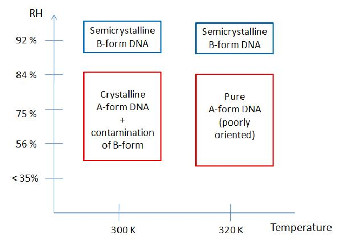 Purification of A-form DNA fibre samples by removal of B-form DNA residues
Purification of A-form DNA fibre samples by removal of B-form DNA residues
To date, fibre diffraction on A-form NaDNA has always shown a B-form
contamination. Here, we have used optic microscopy, calorimetry and
neutron scattering techniques to define a method to obtain DNA fibres
samples whose molecules are purely in the A-form. When the impure sample
is heated to 320 K, the DNA molecules in the B-form undergo a transition
into the A-form. Our studies have modified the accepted phase diagram for
NaDNA films by
including the dependence of temperature crucial for the purification of
A-form samples by removal of B-form contamination.
Reference: Jessica Valle-Orero, Andrew Wildes, Jean-Luc Garden and Michel
Peyrard, J. Phys. Chem. B 117, 1849-1856 (2013)
Journal article
reprint
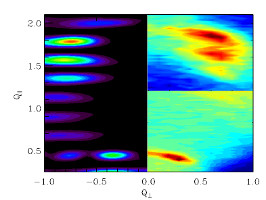
Thermal denaturation of A-DNA
The DNA molecule can take various conformational forms. Investigations focus
mainly on the so-called ``B-form", schematically drawn in the famous paper by
Watson and Crick. This is the usual form of DNA in a
biological environment and is the only form that is stable in an aqueous
environment. Other forms, however, can teach us much about DNA. They have the
same nucleotide base pairs for ``building blocks'' as B-DNA, but with different
relative positions, and studying these forms gives insight into the
interactions between elements under conditions far from equilibrium in the
B-form. Studying the thermal denaturation is particularly interesting because
it provides a direct probe of those interactions which control the growth of
the fluctuations when the ``melting'' temperature is approached. Here we report
such a study on the ``A-form" using calorimetry and neutron scattering. We
show that it can be carried further than a similar study on B-DNA, requiring
the improvement of thermodynamic models for DNA.
Reference: J Valle-Orero, A R Wildes, N Theodorakopoulos, S
Cuesta-Lopez, J-L Garden, S Danikin, and M Peyrard,
New. J. Phys. 16, 113017-1-14 (2014)
Journal article (open access)
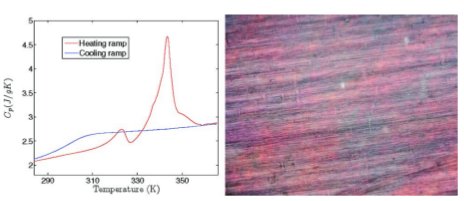 Glassy behavior of denatured DNA films studied by Differential
Scanning Calorimetry
Glassy behavior of denatured DNA films studied by Differential
Scanning Calorimetry
We use differential scanning calorimetry (DSC) to study the properties
of DNA films, made of oriented fibers, heated above the thermal
denaturation temperature of the double helical form. The films show
glassy properties that we investigate in two series of experiments, a
slow cooling at different rates followed by a DSC scan upon heating, and
aging at a temperature below the glass transition. Introducing the
fictive temperature to characterize the glass allows us to derive
quantitative information on the relaxations of the DNA films, in
particular to evaluate their enthalpy barrier.
A comparison with similar aging
studies on PVAc highlights some specificities of the DNA samples.
Reference: Jessica Valle-Orero, Jean-Luc Garden, Jacques Richard, Andrew Wildes
and Michel Peyrard, J. Phys. Chem. B 116, 4394-4402 (2012)
Journal article reprint
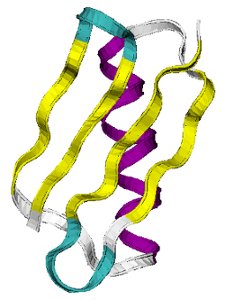 Characterization of the low temperature properties of a
simplified protein model.
Characterization of the low temperature properties of a
simplified protein model.
Prompted by results that showed that a simple protein model, the
frustrated Go model, appears to exhibit a transition reminiscent of
the protein dynamical transition, we examine the validity of this model
to describe the low-temperature properties of proteins. First, we
examine equilibrium fluctuations. We calculate its incoherent
neutron-scattering structure factor and show that it can be well
described by a theory using the one-phonon approximation. By performing
an inherent structure analysis, we assess the transitions among energy
states at low temperatures. Then, we examine non-equilibrium
fluctuations after a sudden cooling of the protein. We investigate the
violation of the fluctuation--dissipation theorem in order to analyze
the protein glass transition. We find that the effective temperature
of the quenched protein
deviates from the temperature of the thermostat, however it relaxes towards
the actual temperature with an an Arrhenius behavior as the waiting time
increases. These results of the equilibrium and non-equilibrium studies
converge to the conclusion that the apparent dynamical transition of
this coarse-grained model cannot be attributed to a glassy behavior.
Reference: J.-G. Hagmann, N. Nakagawa and M. Peyrard,
Phys. Rev. E 89 012705-1-13 (2014)
reprint
Critical examination of the inherent-structure-landscape
analysis of two-state folding proteins
Recent studies attracted the attention on the inherent structure landscape
(ISL) approach as a reduced description of proteins allowing to map their
full
thermodynamic properties. However, the analysis has been so far limited to
a single topology of a two-state folding protein, and the simplifying
assumptions of the method have not been examined. In this work, we construct
the thermodynamics of four two-state folding proteins of different sizes and
secondary structure by MD simulations using the ISL method, and critically
examine possible limitations of the method. Our results show that the ISL
approach correctly describes the thermodynamics function, such as the
specific heat, on a qualitative level. Using both analytical and
numerical methods, we show that some quantitative limitations cannot be
overcome with enhanced sampling or the inclusion of harmonic corrections.
Reference: J.-G. Hagmann, N. Nakagawa and M. Peyrard,
Phys. Rev. E 80 061907-1-11 (2009)
reprint
The Inherent Structure Landscape of a Protein.
We use an extended Go model
to study the energy landscape and the
fluctuations of a model protein. The model exhibits two transitions,
folding and dynamical transitions, when changing the temperature.
The inherent structures corresponding
to the minima of the landscape are analyzed and we show how their energy
density can be obtained from simulations around the folding
temperature. The scaling of this energy density
is found to reflect the folding transition.
Moreover, this approach allows us to build a reduced
thermodynamics in the Inherent Structure Landscape. Equilibrium studies, from
full MD simulations and from the reduced thermodynamics, detect
the features of a dynamical transition at low temperature and we analyze
the location and timescale of the fluctuations of the protein, showing
the need of some frustration in the model to get realistic results.
The frustrated model also shows the presence of a kinetic
trap which strongly affects the dynamics of folding.
References:
Naoko Nakagawa and Michel Peyrard,
Proc. Natl. Acad. Sci. USA (PNAS) 103, 5279-5284 (2006)
(reprint)
and Naoko Nakagawa and Michel Peyrard,
Phys. Rev. E 74 041916-1-17 (2006)
(reprint)
Hydration water, charge transport and protein dynamics.
The hydration water of proteins is essential to biological activity
but its properties are not yet fully understood.
A recent study of dielectric relaxation of hydrated proteins
[A. Levstik et al., Phys. Rev E. {\bf 60} 7604 (1999)] has found a
behavior typical of a proton glass, with a glass transition of about
268K. In order to analyze these results, we investigate the
statistical mechanics and dynamics of a model of
``two-dimensional water'' which describes the hydrogen bonding scheme
of bounded water molecules. We discuss the connection between the
dynamics of bound water and charge transport on the protein surface
as observed in the dielectric measurements.
Reference: M. Peyrard, Hydration water, charge transport and
protein dynamics. J. of Biological Physics 27, 217-228 (2001)
(preprint)
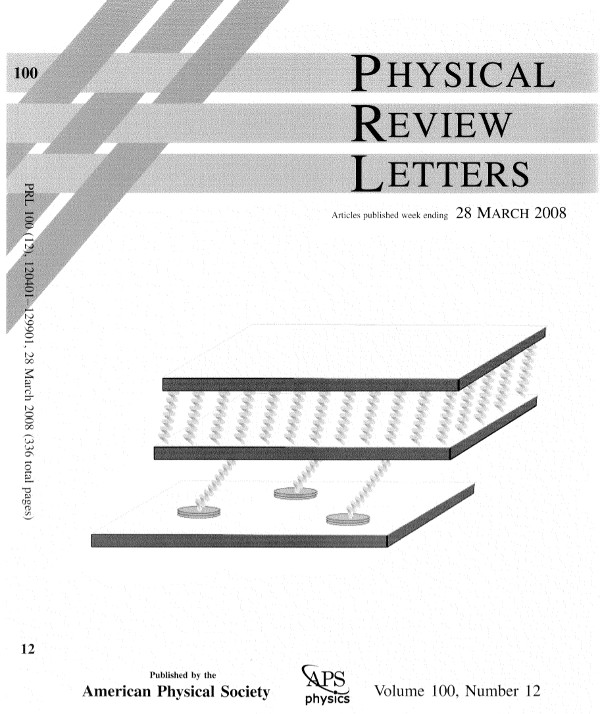
In spite of its crucial practical importance, friction is still far
from being fully explained. Besides a proper
explanation
of the static friction laws, the dynamical aspects of friction are even
less understood. This is exemplified by the
problem posed by the lack of a well established mechanism for
the familiar stick-slip phenomenon that one perceives with a door's
creak or the playing of a violin with a bow.
Many phenomena in nature, where one part of a system moves in contact with
another part, exhibit such a stick-slip motion which changes to smooth
sliding with the increase of the driving velocity.
One of the difficulties is that friction involves many length
scales. We feel it at macroscopic scale, but it arises from numerous tiny
contacts at the micron scale.
Modeling friction on a mesoscale: Master equation for the
earthquake-like model
The earthquake-like model
with a continuous distribution of static thresholds
is used to describe the properties of solid friction.
The evolution of the model is reduced to a master equation which can be
solved analytically.
This approach naturally describes stick-slip and smooth sliding
regimes of tribological systems within a framework which separates the
calculation of the friction force from the studies of the properties
of the contacts.
References: O.M. Braun and M. Peyrard, PRL 100, 125501-1-4 (2008)
(reprint)
O.M. Braun and M. Peyrard, Phys. Rev. E 82, 036117-1-19 (2010)
(reprint)
Dependence of kinetic friction on velocity: Master equation approach
We investigate the velocity dependence of kinetic friction with a
model which makes minimal assumptions on the actual mechanism of
friction so that it can be applied at many scales provided the system
involves multi-contact friction. Using a recently developed master
equation approach we investigate the influence of two concurrent
processes. First, at a nonzero temperature thermal fluctuations allow
an activated breaking of contacts which are still below the threshold.
As a result, the friction force monotonically increases with velocity.
Second, the aging of contacts leads to a decrease of the friction
force with velocity. Aging effects include two aspects: the delay in
contact formation and aging of a contact itself, i.e., the change of
its characteristics with the duration of stationary contact. All
these processes are considered simultaneously with the master equation
approach, giving a complete dependence of the kinetic friction force
on the driving velocity and system temperature, provided the interface
parameters are known.
Reference: O.M. Braun and M. Peyrard,
Phys. Rev. E 83, 046129-1-9 (2011)
(reprint)
Role of aging in a minimal model of earthquakes
Reference: O.M. Braun and M. Peyrard, Phys. Rev. E 87, 032808-1-7 (2013)
(reprint)
Seismic quiescence in a frictional earthquake model
Many earthquakes are preceded by foreshocks, but their frequency can
nevertheless vary widely depending on the type of earthquake. Moreover, some
earthquakes are preceded by an unexpected calm period, lasting for several
hours or more. It is such a period of quiescence, viewed as a characteristic
feature of the imminence of the main shock that allowed the only successful
prediction of an earthquake, which saved a large number of lives in China in
1975.
The existence of some activity before a major earthquake does not seem
surprising, but the fact that a quiescence period could be a characteristic
announcement of an earthquake looks more surprising. Various mechanisms have
been considered to explain seismic quiescence but its generic origin was still
an open question. In this article we propose a generic mechanism related to the
distribution of the threshold for the breaking of the contacts along a fault
and illustrate it by simulations of a simple earthquake model. Our model shows
that seismic quiescence may emerge from what could, at first glance, be
considered as a secondary effect, the aging of the contacts, which in turn may
strongly alter the distribution of the thresholds at which contacts break and
qualiatively change the pattern of foreschocks.
Reference: O.M. Braun and M. Peyrard, Geophys. J. Int. 213,
676-683 (2018)
(article)
The Journal of Biological Physics:
Many physicists are now turning their attention to
domains which were not traditionally part of physics and are applying
the sophisticated tools of theoretical and experimental physics to
investigate new fields, such as biological processes.
The Journal of Biological Physics (JBP)
provides a medium where this
growing community of physicists can publish its results and discuss
its aims and methods.
The journal welcomes papers which use the tools of physics, both
experimental and theoretical, in an innovative way, to study
biological problems, as well as research aimed at providing a better
understanding of the physical principles underlying biological
processes.
All areas of biological physics can be addressed, from the molecular
level, through the mesoscale of membranes and cells, up to the
macroscopic level of a population of living organisms - the main
criteria of acceptance being the physical content of the research and
its relevance to biological systems. In order to increase the links
between physics and biology and among the various fields of biological
physics, authors are advised to include a first section that
introduces the basic issues addressed and the primary achievements to
a non-specialist reader.
In addition to original research papers, JBP
welcomes review papers which call the attention of
physicists to interesting unresolved biological problems that deserve
investigation by physical methods. Special issues, published under the
supervision of a guest editor, containing a series of papers devoted
to a particular topic in addition to the regular papers, can also be
published. They may be invited by the board but suggestions for a
topical issue can also be accepted. They will be
discussed with the editor. Book
reviews are also welcome. Moreover, as a link between physicists
interested in biological problems, JBP can also publish
information such as meeting announcements or conference proceedings.
For further information, right-click to open journal web page in a new window.